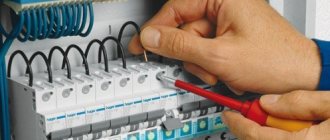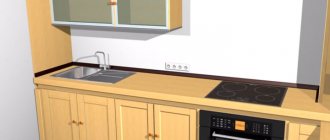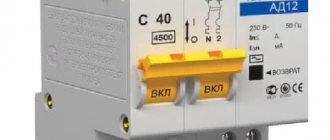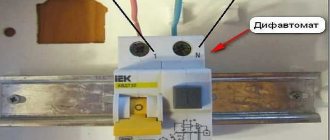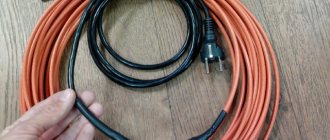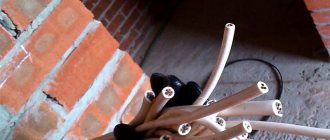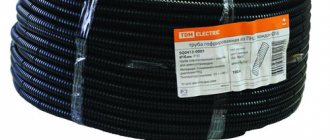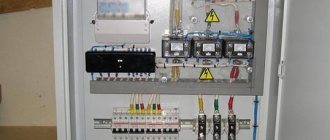The purpose of a circuit breaker (hereinafter referred to as AB) is to protect electrical wiring and electrical equipment from short circuits (hereinafter referred to as short circuit) and overload. If you do not use such AVs in the network, then over time an accident may occur, that is, a short circuit in electrical wiring, electrical appliances or power tools. If not a short circuit, then an overload in the operation of electrical equipment.
In the first and second cases, the wire or cable will heat up, which means the insulation will melt. The wires will short out, a short circuit will occur, which means fire, sparks and ultimately a fire.
To prevent this from happening, AVs are used as protection against possible unpleasant consequences.
How does AB protect electrical wiring and electrical appliances and tools? If, simply put, there is a special device inside this switch that provides instantaneous shutdown of the voltage supply if there is a short circuit or overload problem.
Selecting a machine based on cable cross-section and load power
For quite some time now, modern homes have stopped using corks. They were replaced by more technological devices - automatic machines, also known as baggers, although some still call them traffic jams, but this is wrong, because the operating principle of a traffic jam and a machine is somewhat different. Since in this article we will consider the selection of a machine depending on the cable cross-section, there will be no talk about traffic jams.
So, the machine is a device that allows you to open the electrical circuit automatically in two cases:
- line current overload;
- occurrence of a short circuit (SC).
In the first case, overload occurs due to a malfunction of electrical appliances or their large number and power density. In the second case, due to a short circuit, electricity is consumed to heat the wires with the maximum possible current for this section. In addition to the above cases of circuit breakage, the machine provides the possibility of manual control. There is a switch on the body of the device that allows you to open the circuit.
The purpose of the circuit breaker is to protect the section of the electrical circuit for which it is installed, as well as timely opening of this section in the event of an overload or short circuit.
Importance of time-current characteristic
Some electrical appliances have a high inrush current when turned on. Its value may be higher than the rated current of the machine, but it operates for a short time. For an electric cable, such a current does not pose a danger (if its value is within reasonable limits related to the type of cable), but the machine can be triggered by the starting current, perceiving it as an overload.
In order to avoid constant shutdowns due to the startup of devices with high inrush currents, the machines are divided into types according to the time-current characteristic.
Structurally, the automatic circuit breaker consists of two releases: electromagnetic and thermal.
The electromagnetic release is designed to disconnect the device in the event of a short circuit. To operate this shutdown mechanism, the machine uses an electromagnetic coil and solenoid. When the electric current value is exceeded many times, a magnetic field appears in the coil, which activates the solenoid and it turns off the machine.
Automatic circuit breakers have a short-circuit current characteristic (maximum shutdown current), which is rated at 3, 4.5, 6 and 10 kA. For domestic purposes, when installing protection in an apartment or house, circuit breakers with a short-circuit current rating of 6 kA are most often used.
The thermal release is a plate consisting of two different metals. With a prolonged load exceeding the rated current, this plate heats up, bends, acts on the release lever and the device turns off. The main task of such a mechanism is to protect the line from long-term overloads above the rated current of the machine.
In order not to think about what load to plug into the outlet , not to constantly calculate the total power of devices and not to think about starting currents, a time-current characteristic was invented.
This characteristic shows the time and current that affect the shutdown of the device. On slot machines it is indicated by the letter B, C or D.
Circuit breakers with the same ratings and different time-current characteristics will turn off at different times and with different excess currents.
This separation of machines is very convenient and allows you to reduce the number of false shutdowns.
In accordance with GOST R 50345-2010, there are three standards for time-current characteristics:
- B – 3-5 times the rated current, the most sensitive machines have this characteristic and are used in networks with devices that do not have high starting currents.
- C - 5 - 10 times the rated current, the most popular machines with this characteristic, they are used in apartments and private houses.
- D – 10-20 times the rated current, used to protect networks with equipment with high inrush currents and short-term overloads.
How to calculate the power of a machine
In order to provide the most effective and accurate overload protection, the formula is used to calculate the machine’s power for a 220V network:
in which the rated current is expressed by I, the sum of the powers of all powered consumers including lighting devices is P, and the voltage of the electrical network is U. Thus, the value of the rated current will increase with an increase in the total power of consumers.
And for a 380V network, the power calculation of the machine is made according to the formula:
in which the cosφ value is added, meaning the power factor (the exact value can be found in Table 6.12 of the SP 31-110-2003 standard “Design and installation of electrical installations in residential and public buildings”). To simplify calculations in everyday conditions, cosine phi is taken equal to one. In general, this coefficient depends on the type of electrical receiver, for example:
- for lighting networks with fluorescent lamps, the power factor is 0.92;
- for lighting networks with incandescent lamps - one;
- for gas-light advertising installations - from 0.35 to 0.4;
- for computers without technological air conditioning - 0.65;
- for refrigerators and air conditioners with an electric motor up to 1 kW, cosφ is equal to 0.65, and with a motor of 1 - 4 kW, the power factor increases to 0.75.
Let's try to calculate the machine's power using an example. Let's say you are trying to protect a group of three kitchen outlets from short circuits. In one, a refrigerator with a power of 400 W is constantly turned on, in others, a microwave or kettle (1000 W) or a blender (300 W) is periodically connected. Let's calculate the total power if you want to simultaneously connect the most powerful devices: 400 + 1000 + 1000 = 2400 W. The current strength for a 220V network is as follows:
And we recommend choosing a machine based on power in favor of the closest 10A rating. A natural concern may arise: will it “knock out” when applying more voltage to such a nominal value? In fact, if you apply a load of 15 amps to a 10-amp protective device, the operation will occur in eight minutes, and if you apply 11 amps, then it will take as long as twenty minutes. During this time, the kettle will turn off and the load will again become acceptable - much earlier than the release switches on.
How to choose a circuit breaker in the case of a three-phase input, which is relevant for private houses and some new buildings? You can either use the power factor formula or refer to the table.
Nuances
In general, readers should not have any questions regarding the selection of packages according to the cable cross-section, but there are some subtleties that we did not mention above.
- A machine with which type of electromagnetic release to choose. In everyday life, machines of categories “B” and “C” are most often used. This is due to the fastest possible operation of package switches when the rated current is exceeded. This is extremely important when using appliances such as electric kettles, toasters and irons. Depending on the type of equipment used, you should choose a specific category; it is advisable to give preference to category “B” switches.
- A machine with a maximum switching capacity to choose. Depends on the location of the electricity input from the substation to the apartment, if in close proximity, then you should choose one with a switching capacity of 10,000 amperes, otherwise for city apartments there are enough devices for 5,000–6,000 amperes. You can play it safe and choose the option of 10,000 amperes; ultimately, this indicator only affects whether the machine will be operational after a short circuit.
- What type of wire to choose: aluminum or copper We strongly do not recommend purchasing aluminum conductors. Copper wiring is more durable and can handle higher currents.
Cables GOST 31996–2012
When choosing a machine, it is necessary to take into account the characteristics of the cables. The most important is the permissible current (Iperm). It shows at what maximum current the cable can operate throughout its entire service life. This table from the PUE contains information about permissible cable currents depending on the material and conditions of cable laying.
Permissible currents for cable depending on materials
| Open wiring | Cable cross-section, mm2 | Closed wiring | ||||||||||
| Copper | Aluminum | Copper | Aluminum | |||||||||
| Current A | Power, kWt | Current A | Power, kWt | Current A | Power, kWt | Current A | Power, kWt | |||||
| 220 V | 380 V | 220 V | 380 V | 220 V | 380 V | 220 V | 380 V | |||||
| 11 | 2.4 | — | — | — | — | 0.5 | — | — | — | — | — | — |
| 15 | 3.3 | — | — | — | — | 0.75 | — | — | — | — | — | — |
| 17 | 3.7 | 6.4 | — | — | — | 1 | 14 | 3 | 5.3 | — | — | — |
| 23 | 5 | 8.7 | — | — | — | 1.5 | 15 | 3.3 | 5.7 | — | — | — |
| 26 | 5.7 | 9.8 | 21 | 4.6 | 7.9 | 2 | 19 | 4.1 | 7.2 | 14 | 3 | 5.3 |
| 30 | 6.6 | 11 | 24 | 5.2 | 9.1 | 2.5 | 21 | 4.6 | 7.9 | 16 | 3.5 | 6 |
| 41 | 9 | 15 | 32 | 7 | 12 | 4 | 27 | 5.9 | 10 | 21 | 4.6 | 7.9 |
| 50 | 11 | 19 | 39 | 8.5 | 14 | 6 | 34 | 7.4 | 12 | 26 | 5.7 | 9.8 |
| 80 | 17 | 30 | 60 | 13 | 22 | 10 | 50 | 11 | 19 | 38 | 8.3 | 14 |
| 100 | 22 | 38 | 75 | 16 | 28 | 16 | 80 | 17 | 30 | 55 | 12 | 20 |
| 140 | 30 | 53 | 105 | 23 | 39 | 25 | 100 | 22 | 38 | 65 | 14 | 24 |
| 170 | 37 | 64 | 130 | 28 | 49 | 35 | 130 | 29 | 51 | 75 | 16 | 28 |
From this table you can find the required cable cross-section and permissible current depending on the wiring conditions, open or buried. For example, the power of all appliances in the apartment is 9 kW. For open single-phase copper wiring, the wire cross-section is 4 mm 2, current 41A, for closed - the nearest higher power value is 11 kW, cross-section 10 mm 2, current 50A. The nearest lower rating of the circuit breaker is 32A.
If there is doubt about the quality of the electrical wiring, then it is better to exercise caution and choose a machine with a rating lower than the value in the table.
The residential network has a branched structure: a current of different strength will flow in each branch, so the wires have different cross-sections. If you install one circuit breaker only at the entrance, it will not be able to protect individual sections of the wiring from overload. If the entire network is laid with a cable of the same cross-section, then this is an unjustified financial expense. The best solution would be to install the appropriate current on each section of the machine. The figure shows an approximate structure.
Installation of machines for the appropriate current
The figure clearly shows the load on each section and the cross-section of the wire. By installing appropriate circuit breakers, you can reliably protect the entire network from short circuits or overloads. In addition, at any time it is possible to select and disable one or another section, maintaining the functionality of the rest of the network.
When using powerful asynchronous motors in everyday life, especially 3-phase ones, for example, power tools, it is advisable to turn them on through a separate circuit breaker, since they have a large starting current, and when operating through a common circuit breaker, a power outage may occur even during normal operation of the equipment.
Why won’t the C16 circuit breaker turn off at a current of 16 Amps?
Now let's try to understand why, with an electrical cable cross-section of 2.5 sq. mm, which can withstand a current of 25A (PUE table 1.3.6), it should be protected by a 16A circuit breaker, and not 25A.
It's all about the thermal release, which heats up over time when exposed to load and protects against prolonged overcurrent. The duration of this time can take 10 minutes or 1 hour.
Automatic switches have such a characteristic as “non-switching current”, it is calculated to be 1.13 of the rated current (see GOST R 50345-2010 clause 8.6.2). This characteristic means that the machine will not turn off at this current value for an hour.
For example, a 16A circuit breaker will not turn off if a current of 18.08 A flows through it for an hour; this is included in the operation of the device’s thermal release.
Another characteristic of the machines is the “conditional shutdown current” and it is also standard for all circuit breakers and is equal to 1.45 of the rated current. With a current of, for example, 36.25A, a 25A circuit breaker will definitely turn off within an hour. This rule only applies if the machines were initially cold.
Therefore, you need to keep in mind that circuit breakers do not turn off when the current reaches their rated value. They can work longer, so always choose a protective device with a rating lower than the cable throughput.
What determines the choice of cable cross-section?
The main task of preserving the original functionality of an electrical cable is to prevent it from overheating. This can be solved very simply if 1 mm2 is subjected to a load in the form of a long-term total current not exceeding 9 Amperes. When translating this indicator into a more familiar value for the average person - power, it turns out that a conventional cable with a cross-section of 1 mm2 can be used to power electrical appliances with a power consumption of up to 2 kW. If such numerical transformations cause difficulties, and a special online calculator
is not available at the right time, you just need to remember a few simple rules.
- Cable for lighting – core cross-section 1.5 mm2.
- Cable for all sockets, air conditioning, loggias - core cross-section 2.5 mm2.
- Cable for electric ovens – core cross-section 4 mm2.
- Cable for hobs and instantaneous electric water heaters – core cross-section 6 mm2.
Important! The cable supplying outlets and lighting systems may break, have branches and connections. And all others from the list presented above must be solid. This means that to organize power supply for, say, an oven, a special line of cable with a cross-section of 4 mm2 must be laid directly from the panel, and with the installation of a separate machine. This is a standard and there is no situation that would allow us to deviate from it and organize branches to power other power devices. Any joint on such a line is a minus to durability and reliability.
Why is a short circuit dangerous?
This situation can arise during repairs if an electrician accidentally shorts the neutral and phase wires together, or due to the destruction of insulation in an adapter box or some electrical appliance.
In this case, the current flowing in the wires can grow to a very large value, limited only by the resistance of the wires and the capabilities of the line. In this case, the current-carrying conductors heat up to the temperature at which the insulation ignites, which can lead to a fire, so it is necessary to immediately turn off the power to the line.
Application of measuring instruments
To determine the diameter of the cores of wires and cables, various measuring instruments are widely used, showing the most accurate results. Basically, the use of micrometers and calipers is practiced for these purposes. Despite their high efficiency, a significant drawback of these devices is their high cost, which is of great importance if the tool is planned to be used only 1-2 times.
As a rule, professional electricians who are constantly engaged in electrical installation work use special devices. With the right approach, it becomes possible to measure the diameter of wire cores even on working lines. After obtaining the necessary data, all that remains is to use a special formula:
The result of the calculation will be the area of the circle, which is the cross-section of the wire or cable core.
Concept of electrical network load
The circuit of any standard electrical network in an apartment or private house is divided into several main groups. For each group, a wire or cable of a certain cross-section and an automatic protective device, the rating of which is calculated in advance, are provided.
To correctly select the required parameters for the cross-section of the cable and the machine, calculations of the expected loads for a given electrical network are carried out. Current load is the amount of current generated in the network during operation of the devices. Calculation of the current load for an individual consumer will differ markedly from the same calculations performed for a group of household appliances.
You should also take into account the difference in the calculated loads when connecting single-phase (220V) and three-phase (380V) power. These factors have a direct impact on the correct choice of circuit breakers and cable cross-sections.
Which machine to choose for 2.5 mm2 cable?
For consumers whose total power will not exceed 3.5 kW, we recommend using a copper cable with a cross-section of 2.5 sq. mm and protecting these lines with a 16A automatic.
For a copper cable with a cross-section of 2.5 sq. mm according to Table 1.3.6 of the PUE, the long-term permissible current is 27A. Based on this, you might think that a 25A machine will fit such a cable. But that's not true. By the way, for those who don’t know where to look, I publish this table:
According to the PUE, clause 1.3.10, a current value of 25A will heat up a 2.5 sq. mm cable to 65 degrees Celsius. This is a high enough temperature for constant operating modes.
It is also important to understand that not all manufacturers produce cables in accordance with GOST and its cross-section may be lower than declared. So the cross section could be 2.0 sq.mm instead of 2.5 sq.mm. The quality of copper also differs between factories and you cannot be guaranteed to accurately say what quality of cable you have.
Therefore, a reserve in cable protection is very important to avoid problems during the operation of electrical wiring. The choice of machine according to the cable cross-section is carried out as follows:
- I use a 1.5 sq. mm cable when installing alarms and lighting; it corresponds to a 10A machine;
- a 2.5 sq. mm cable is often used for individual sockets and socket groups, where the total power of consumers will not exceed 3.5 kW. It corresponds to the current ratings of 16A automatic machines;
- a 4 sq. mm cable is used in everyday life to connect ovens, washing machines and dishwashers, heaters and water heaters; they buy a 25A automatic machine for it;
- a 6 sq. mm cable is needed to connect serious powerful consumers: electric stoves, electric heating boilers. Machine rating 32A;
- a cable of 10 sq. mm is usually the maximum cross-section used in everyday life, intended for supplying power to apartments and private houses to electrical panels. Automatic 40A.
To calculate the electrical network at home, boldly and strictly follow the table and guide provided above. With the correct calculation of power lines and protective devices, everything will work for a long time and will not bring you any inconvenience or problems.
Classification of circuit breakers
AB are:
- single-pole, only one phase is connected to it, used where the electricity consumer is 220 V;
- bipolar, two opposite phases or phase and zero are connected to it. As soon as a problem occurs in one of the phases (exceeding the current value), two circuit breakers are switched off at once. They are not used in everyday life;
- three-pole, used where there is a three-phase power transmission system. For example, when entering a cottage, apartment buildings;
- four-pole, used in switchgears (RU), for breaking 3 phases and zero, not used in everyday life.
What are the tariffs for rural areas and for the city?
To a large extent, electricity tariffs depend on the area in which the consumer lives (city or rural area). Thus, the tariff in rural areas will be 30% cheaper than in urban areas.
This point has its own nuances, namely: the reduced (preferential) tariff applies only in rural settlements. Whereas, in the case when a village, both dacha and cottage (for example: DNT, SNT, etc.) does not have the status of a rural municipality (is not located within the boundaries of a rural settlement), then residents will have to pay for electricity at the rates provided for the city. The same rule fully applies to urban settlements (urban-type settlements). Although the standard of living in them, as well as their amenities, does not differ significantly from villages and villages, residents of such urban settlements must pay for consumed electricity at the tariffs provided for the city.
In addition to the above information, we invite readers to watch a video that will tell you exactly how to calculate the cost of 1 kW of electricity and what this amount consists of.
In conclusion, it should be noted that electricity bills should be paid on time and at the tariffs that are provided in a particular region. Only in this case will subscribers not have any problems with regulatory authorities.
Ways to distribute wiring in the house
The number of circuit breakers in the panel is influenced by:
- Number of premises (2, 3-room apartment plus bathroom, kitchen).
- Separating lighting wiring from sockets.
- The presence or absence of high-power household electrical appliances.
1 way of wiring distribution
For each room you will need to install 2 circuit breakers: for sockets and lighting. Separately, it is necessary to draw conclusions about household electrical appliances in the apartment:
- fridge.
- Dishwasher.
- washing machine.
- water heater.
- electric stove.
- air conditioners.
- warm floor.
For example: In a 2-room apartment with a combined bathroom, you need to install 8 auto switches + household appliances.
This method of distributing wiring in an apartment will not be practical. As a result, you will get a lot of wires, work, and money spent than the effect.
2 way of wiring distribution
For 1 room you will need to allocate 1 switch, without separating the light from the sockets. Also remove electrical appliances from the general network.
As a result: a 2-room apartment with a combined bathroom will require 4 machines + household appliances.
With this approach, you will spend less time and financial resources, and the system will be more convenient and easier to use.
You should not skimp on the security of your apartment. But there is no need to do extra work. Make a highly reliable and simple wiring network that is safe and convenient.
How many kilowatts do you need for your home? Electricity consumption table
Our modern society cannot imagine its life without electricity. It is firmly rooted in the daily and industrial life of a person in the twenty-first century.
Electricity is used not only to illuminate streets, residential buildings and other premises. Today, electricity is needed to power the telephone, computer, TV and many other household appliances in our homes, which make the life of a modern person much easier.
Many home owners use electricity for heating, although this is not the cheapest type of heating, it is quite reliable and easy to use.
Like people in the past, modern society cannot exist without electricity. Every year, scientists are developing new technologies that require power. Of course, today electric current is used more widely than before. But after several decades, its consumption will increase several times. So, for example, if 10 years ago 1.5 - 2 kW of electricity was enough for a house or apartment, today this figure has increased to 15 kW, almost 10 times.
Let's try to figure out how many kilowatts a home currently needs.
